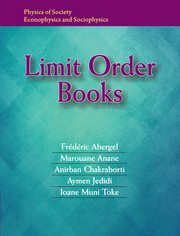Book contents
- Frontmatter
- Contents
- Figures
- Tables
- Foreword
- Preface
- Acknowledgments
- 1 Introduction
- PART ONE EMPIRICAL PROPERTIES OF ORDERDRIVEN MARKETS
- PART TWO MATHEMATICAL MODELLING OF LIMIT ORDER BOOKS
- 5 Agent-based Modelling of Limit Order Books: A Survey
- 6 The Mathematical Structure of Zero-intelligence Models
- 7 The Order Book as a Queueing System
- 8 Advanced Modelling of Limit Order Books
- PART THREE SIMULATION OF LIMIT ORDER BOOKS
- PART FOUR IMPERFECTION AND PREDICTABILITY IN ORDERDRIVEN MARKETS
- Appendix A A Catalogue of Order Types
- Appendix B Limit Order Book Data
- Appendix C Some Useful Mathematical Notions
- Appendix D Comparison of Various Prediction Methods
- Bibliography
7 - The Order Book as a Queueing System
from PART TWO - MATHEMATICAL MODELLING OF LIMIT ORDER BOOKS
Published online by Cambridge University Press: 05 July 2016
- Frontmatter
- Contents
- Figures
- Tables
- Foreword
- Preface
- Acknowledgments
- 1 Introduction
- PART ONE EMPIRICAL PROPERTIES OF ORDERDRIVEN MARKETS
- PART TWO MATHEMATICAL MODELLING OF LIMIT ORDER BOOKS
- 5 Agent-based Modelling of Limit Order Books: A Survey
- 6 The Mathematical Structure of Zero-intelligence Models
- 7 The Order Book as a Queueing System
- 8 Advanced Modelling of Limit Order Books
- PART THREE SIMULATION OF LIMIT ORDER BOOKS
- PART FOUR IMPERFECTION AND PREDICTABILITY IN ORDERDRIVEN MARKETS
- Appendix A A Catalogue of Order Types
- Appendix B Limit Order Book Data
- Appendix C Some Useful Mathematical Notions
- Appendix D Comparison of Various Prediction Methods
- Bibliography
Summary
Introduction
In this chapter, we move forward on the mathematical study of zero-intelligence models by deriving some analytical properties of a limit order book under the assumptions introduced in Section 6.2. The model is then extended to the case of random order sizes, thereby allowing to study the relationship between the size of the incoming limit orders and the shape of the order book.
Recall that the shape of the order book is simply the function which for any price gives the number of shares standing in the order book at that price; and the cumulative shape up to price p is the total quantity offered in the order book between the best limit and price p. If the limit order book is ergodic, the (cumulative) shape admits a stationary distribution, and its expectation with respect to this stationary distribution will be simply called the average (cumulative) shape.
Understanding the average shape of an order book and its link to the order flows is not straightforward. The first empirical observations of the shape of an order book stated that, at least for the first limits, the shape of the order book is increasing away from the spread (Biais et al. 1995). With better data, one can complement this view and state that “the average order book has a maximum away from the current bid/ask, and a tail reflecting the statistics of the incoming orders” (Bouchaud et al. 2002; Potters and Bouchaud, 2003), i.e. that the limit order book is hump-shaped. The decrease of the tail of the order book is difficult to estimate because one needs complete data, including limit orders submitted far away from the best quotes, which is often not disclosed by exchanges. A power law decrease (Bouchaud et al. 2002) or an exponential decrease (Gu et al. 2008) or even a whole lognormal shape (Preis et al. 2006) have been suggested.
The hump-shaped order book appears quite easily in simulations, as we will see later in Chapter 9. Studying simulation results, Cont et al. (2010) observe that “the average profile of the order book displays a hump […] that does not result from any fine-tuning of model parameters or additional ingredients such as correlation between order flow and past price moves”, but no explicit link between the average shape and the order flows is made.
- Type
- Chapter
- Information
- Limit Order Books , pp. 77 - 96Publisher: Cambridge University PressPrint publication year: 2016

